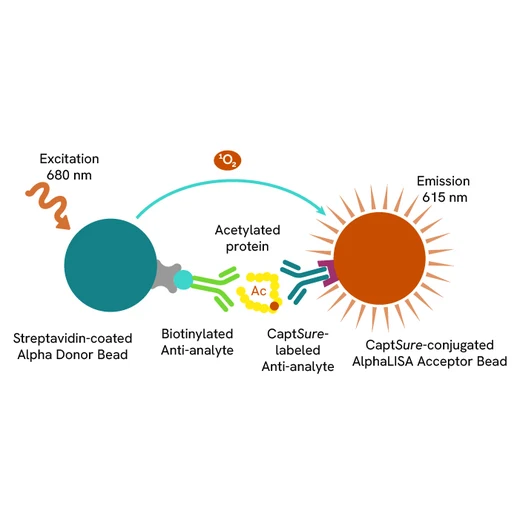
AlphaLISA SureFire Ultra Human Acetyl K382 p53 (Lys382 & total) Detection Kit, 100 Assay Points


 View All
View All
AlphaLISA SureFire Ultra Human Acetyl K382 p53 (Lys382 & total) Detection Kit, 100 Assay Points
















The AlphaLISA™ SureFire® Ultra™ p53 (K382Ac) assay kit can be used to measure levels of p53 acetylated at the Lys382 residue in cellular lysates using no-wash Alpha technology.
For research use only. Not for use in diagnostic procedures. All products to be used in accordance with applicable laws and regulations including without limitation, consumption and disposal requirements under European REACH regulations (EC 1907/2006).
| Feature | Specification |
|---|---|
| Application | Cell Signaling |
| Sample Volume | 30 µL |
The AlphaLISA™ SureFire® Ultra™ p53 (K382Ac) assay kit can be used to measure levels of p53 acetylated at the Lys382 residue in cellular lysates using no-wash Alpha technology.
For research use only. Not for use in diagnostic procedures. All products to be used in accordance with applicable laws and regulations including without limitation, consumption and disposal requirements under European REACH regulations (EC 1907/2006).








AlphaLISA SureFire Ultra Human Acetyl K382 p53 (Lys382 & total) Detection Kit, 100 Assay Points








AlphaLISA SureFire Ultra Human Acetyl K382 p53 (Lys382 & total) Detection Kit, 100 Assay Points








Product information
Overview
Formats:
- The HV (high volume) kit contains reagents to run 100 wells in 96-well format, using a 60 µL reaction volume.
- The 500-point kit contains enough reagents to run 500 wells in 384-well format, using a 20 µL reaction volume.
- The 10,000-point kit contains enough reagents to run 10,000 wells in 384-well format, using a 20 µL reaction volume.
- The 50,000-point kit contains enough reagents to run 50,000 wells in 384-well format, using a 20 µL reaction volume.
In the AlphaLISA™ SureFire® Ultra™ assay, Donor beads are coated with streptavidin to capture one of the antibodies, which is biotinylated. Acceptor beads are coated with a proprietary CaptSure™ agent that immobilizes the other antibody, labeled with a CaptSure™ tag. In the presence of acetylated protein, the two antibodies bring the Donor and Acceptor beads close together, generating signal. The amount of light emission is directly proportional to the amount of acetylated protein present in the sample.
AlphaLISA™ SureFire® Ultra™ kits are compatible with:
- Cell and tissue lysates
- Antibody modulators
- Biotherapeutic antibodies
Alpha SureFire® kits can be used for:
- Cellular kinase assays
- Receptor activation studies
- Screening
Specifications
| Application |
Cell Signaling
|
|---|---|
| Automation Compatible |
Yes
|
| Brand |
AlphaLISA SureFire Ultra
|
| Detection Modality |
Alpha
|
| Lysis Buffer Compatibility |
Lysis Buffer
|
| Molecular Modification |
Acetylation
|
| Product Group |
Kit
|
| Sample Volume |
30 µL
|
| Shipping Conditions |
Shipped in Blue Ice
|
| Target |
p53
|
| Target Class |
Phosphoproteins
|
| Target Species |
Human
|
| Technology |
Alpha
|
| Unit Size |
100 Assay Points
|
Image gallery






AlphaLISA SureFire Ultra Human Acetyl K382 p53 (Lys382 & total) Detection Kit, 100 Assay Points






AlphaLISA SureFire Ultra Human Acetyl K382 p53 (Lys382 & total) Detection Kit, 100 Assay Points






Video gallery


AlphaLISA SureFire Ultra Human Acetyl K382 p53 (Lys382 & total) Detection Kit, 100 Assay Points


AlphaLISA SureFire Ultra Human Acetyl K382 p53 (Lys382 & total) Detection Kit, 100 Assay Points


Resources
Are you looking for resources, click on the resource type to explore further.
This guide outlines further possible optimization of cellular and immunoassay parameters to ensure the best possible results are...
Discover Alpha SureFire® Ultra™ assays, the no-wash cellular kinase assays leveraging Revvity's exclusive bead-based technology...
Therapeutic antibodies directed to cell surface receptors are increasingly being developed as treatments for a variety of diseases...
The measurement of protein phosphorylation is a useful tool for measuring the modulation of receptor activation by both antibodies...
An in-depth review of molecular and cellular pathways
The maintenance of proteostasis, the biological mechanisms that control the...


How can we help you?
We are here to answer your questions.






























